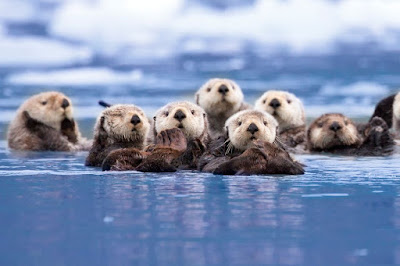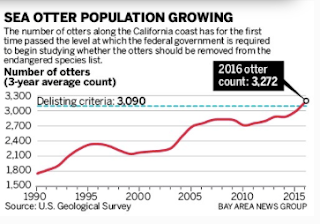Southern Sea Otters
By: Natalie LaFollette
Image from: http://animals.nationalgeographic.com/animals/mammals/sea-otter/
When I was a kid, one of my favorite places to visit was the Monterey Bay Aquarium. My dad would take me there all the time. We never missed the opening of new exhibit and always went to see the juvenile Great White Sharks on display in their open ocean tank. Over the years, my favorite exhibit has been the sea otters. They are adorable and charismatic, but also powerful swimmers and hunters. I know that I am not alone in my admiration for these marine mammals.
Overview:
Southern Sea Otters (Enhydra lutris nereis) are members of the weasel family and are one of the smallest marine mammals in the world (The Marine Mammal Center). Their trademark characteristic is their extremely dense fur. Otters have two layers of fur, an undercoat and guard hairs, which together add up to at least 650,000 hairs per square inch. That’s a lot of hair! Air is trapped between the layers of fur, which prevents an otter’s skin from getting wet. Young pups have such a large layer of air that they cannot dive and instead float on the surface while their mothers look for food. The otters’ fur keeps them warm in cold waters, but also made them a target for hunters in the 1700 and 1800s (US Fish and Wildlife Service). It is estimated that there were once about 16,000 Southern Sea Otters along California’s coast. Hunting was so extensive that otters were thought to be extinct until a small group was discovered in Big Sur in the late 1930s. All Southern Sea Otters today are descendants of this group. Southern Sea Otters are often called California Sea Otters and are a distinct population from Northern Sea Otters (Recovery Plan). Northern Otters were also hunted extensively, but their populations in Alaska, Russia, and Japan have recovered more quickly than their southern cousins.
Southern Otters are smaller in size than other sea otters (Recovery Plan). Males are about four and a half feet long and weigh sixty-five pounds. While females are about four feet long and weigh forty-five pounds. Southern Otters prefer to live close to shore in areas with extensive kelp forests (The Marine Mammal Center). They use the kelp to anchor themselves and their pups so that they do not float away while sleeping or resting. Kelp forests also provide otters with large amounts of prey. They feed mostly on small, bottom-dwelling invertebrates and use rocks to break open clams and abalone shells. Since they have fur and not blubber to protect them from the cold, they must eat large quantities of food to maintain their body temperature. An otter will regularly eat 15-25% of its weight everyday. That’s a lot of shellfish!
Image from: http://seaotters.com/
Southern Sea Otters live about fifteen to twenty years and begin reproducing when they are between three and five years old (US Fish and Wildlife Service). A female will usually have a single pup every year. Most pups are born sometime between February and April, but they can be born at anytime of the year. While Southern Sea Otter birth rates have been rising, external threats are preventing them from regaining their former range and population levels.
< Population Distribution and Current Range: Southern Sea Otters were once found along California’s entire coastline (Recovery Plan). Today, their range is limited to the central coast with major population centers in Monterey Bay, Morro Bay, and Pismo Beach. There is also a small population living near San Nicolas Island. They were transplanted there by researches in a failed attempt to establish an otter population along the coast south of Point Conception, CA.
Image from: http://news.ucsc.edu/2014/09/sea-otter-population.html
Recovery Plan:
The Southern Sea Otter is listed as threatened under the Endangered Species Act of 1973 and as depleted under the Marine Mammal Protection Act of 1972 (Recovery Plan). The species was first listed in 1982. By 1989, scientists had decided that they needed to make some modifications to the 1982 recovery plan. Drafts of the new plan were released in 1991, 1996, and 2000. A new finalized Recovery Plan was released in 2003. That took a while! The otters were originally listed because of their small population size and concerns that a single oil spill could wipe out the entire population.
Today, oil spills still remain the single largest threat to the sea otter population in California. When an otter’s fur is exposed to oil, it can no longer form the layer of air that is necessary to keep them warm (Recovery Plan). Conservative estimates say that a large oil spill would kill at least 50% of otters that came in contact with it. The recovery plan states that researchers should work with the US Coast Guard to monitor drilling activities and oil tankers. With information provided by the Coast Guard, researchers can monitor the risks to otter populations. The plan also calls for an oil spill response plan, which would address how to aid otters if a major spill were to occur along the central coast.
Disease is a major cause of otter mortality (Recovery Plan). Infectious diseases can easily be spread when otters congregate together or between mothers and pups. The recovery plan calls for researchers to collect tissue samples from otters to do research into potential cures for diseases. Researchers also need to determine if any stressors are making otters more susceptible to disease. For example, an otter that lives in an area where it is frequently interrupted and harassed by humans might be less fit than other individuals. Therefore, it may be more likely to get an infection.
Incidental take of otters from fishing is also a threat. The magnitude of this threat is difficult to determine and the recovery plan calls for more data to be collected about the causes of otter mortality in general. The plan also asks that fishing regulations be reexamined to ensure that fishermen are taking measures to prevent sea otter take.
An emerging threat to otters in California is Great White Shark attacks (US Fish and Wildlife Service). At the time that the Recovery Plan was finalized, this was not a major cause of otter mortality. However, in recent years white shark attacks have grown increasingly common. Researchers are still working to determine the cause for this. A possible explanation is the increase in the seal populations in California, which is attracting more Great Whites to the central coast (Rogers).
In order for Southern Sea Otters to be delisted, the species population would have to be above 3,090 individuals for at least 3 years (Recovery Plan). A 2016 survey found that there are currently 3,272 otters along California’s central coast (Rogers). While two more years of data are needed to determine if the otter should be delisted, these are encouraging findings for researchers and otter enthusiasts like myself!
Graph from: http://www.mercurynews.com/2016/09/19/california-sea-otter-population-reaches-record-high-number/
What you can do:
Additional Resources:
- http://www.defenders.org/sea-otter/basic-facts
- http://www.montereybayaquarium.org/animal-guide/marine-mammals/southern-sea-otter
- http://www.aquariumofpacific.org/exhibits/otters
- http://animals.nationalgeographic.com/animals/mammals/sea-otter/
- https://www.mmc.gov/priority-topics/species-of-concern/southern-sea-otter/
- http://www.werc.usgs.gov/project.aspx?projectid=91
Works Citied:
"Final Revised Recovery Plan for the Southern Sea Otter." US Fish And Wildlife Service. N.p., 24 Feb. 2003. Web. 25 Nov. 2016. <https://ecos.fws.gov/docs/recovery_plan/030403.pdf>.
Rogers, Paul. "California Sea Otter Population Reaches Record High Number." The Mercury News. N.p., 19 Sept. 2016. Web. 27 Nov. 2016. <http://www.mercurynews.com/2016/09/19/california-sea-otter-population-reaches-record-high-number/>.
"Sea Otter." The Marine Mammal Center. N.p., 2016. Web. 25 Nov. 2016. <http://www.marinemammalcenter.org/education/marine-mammal-information/sea-otter.html>.
"Southern Sea Otter." Ventura Fish and Wildlife Office. US Fish and Wildlife Service, 2016. Web. 25 Nov. 2016. <https://www.fws.gov/ventura/endangered/species/info/sso.html>.












